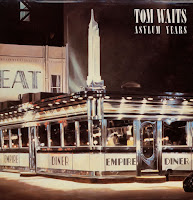M and I went to see Kasabian at Wembley Arena on Sunday night. Wembley is quite possibly my least favourite venue, a feeling that was enhanced on Sunday by public transport issues and further compounded by not being especially bothered about seeing the band. M’s a fan, whereas I can’t seem to get past front man Tom Meighan’s laddish persona or Serge Pizzorno’s adoption of every rock pose in the Spinal Tap rulebook.
All that said, the most recent Kasabian album, West Ryder Pauper Lunatic Asylum is a great album, as are their previous two come to think of it. As a live band, they’ve obviously more than mastered the dark art of stadium histrionics, which I often find irritating, but you have to concede they do it very well. So it’s fair to say, once I’d got past Wembley’s consistently terrible sound and the band’s onstage aloofness, I was really, really impressed… eventually.

The band arrived on their ephemera-cluttered and asylum-themed stage with the ‘Underdog’ B-side ‘Julie & The Moth-Man’, an upbeat crowd-pleaser which betters a number of tracks on West Ryder. The trouble was that the song packed such an instant sonic punch and required so much energy from the band that it took them several songs to get anywhere close to that song’s impact again. Consequently the single ‘Underdog’ fell flat, as did ‘Where Did All The Love Go’, one of my favourite tracks from the album. All was well by the crowd-sung coda of the anthemic encore track ‘L.S.F. (Lost Souls Forever)’, which carried on out of the stadium, into the Underground station and probably all the way to Baker Street. Even The Mighty Boosh’s Noel Fielding put in a typically creepy, elastic-limbed performance to a rapturous audience reception.
That reception was rightfully not extended to the second support act, Reverend & The Makers, a band who seem to rely on their front man’s aggressive, crowd-baiting arrogance and drunk-bloke-on-a-night-out posturing in the absence of a clear sonic identity. I wouldn’t say that their songs were necessarily bad, and they certainly seem keen to mine the same cocky electro-rock seam as Kasabian, but in comparison they are undoubtedly a much more mediocre offering. That, combined with the front man’s sub-Gallagher attitude and the skinny girl who seemed to be performing some sort of trite exercise routine behind her keyboards, and you get a band that will always be second on the bill.
On the train this past week I’ve listened to Grinderman’s eponymous debut. Grinderman is essentially a Nick Cave side-project, featuring a slimmed-down Bad Seeds and Cave himself on guitar for the first time. Described by Esquire magazine as ‘one of [the] five best mid-life crisis albums‘, the sound of Grinderman is the closest the latter-day Cave has managed to get to reclaiming the ur-punk nihilism of his earlier band The Birthday Party, the overall sound being one of atonal thrashing and noisy blues. My favourite track is the wild garage rock assault of ‘Honey Bee (Let’s Fly To Mars)’ with insectoid sibilant rasps from Cave in the style of The Cramps’s sadly-departed Lux Interior on the similarly bugtastic ‘Human Fly’.

Tom Waits’s Asylum Years was a weekend purchase, and provides my first immersion into the barrel-aged jazz torch songs of Waits’s seventies output on Asylum Records. Tom’s vocal sound is one that initially made for uncomfortable listening until I finally cottoned on to his Louis Armstrong-esque depth and tone. It is truly for artists like Waits that the oft-misused term noir was designed for, his emotionally-wrought songs clashing effortlessly with nocturnal tales of schlepping round New York’s seediest neighbourhoods, while all along you feel that a glass of bourbon was never far from Tom’s microphone stand. Next stop, Swordfishtrombones.

Magazine cover CDs are usually put together with a slapdash, unit-shifting mentality, but not The Velvets Revolution compilation given away with this month’s Uncut. The CD consists of fifteen artists supposedly influenced by The Velvet Underground and for once – with probably one exception from Espers – the tracks really do capture the spirit of the band Uncut are trying to draw comparisons with. It’s worth buying the magazine anyway for the profile and focus on the band, but the CD’s tracks from the likes of Suicide, Loop and the Brian Eno / Phil Manzanera project 801 all evidence the wide-ranging impact the Velvets have had on modern music, whether that be dirge-like scrapings (Fursaxa), motorik ‘Sister Ray’-inspired punk (Thee Oh Sees) or genteel Nico / Moe Tucker balladry (Hope Sandoval & The Warm Intentions).




No comments:
Post a Comment